


 |
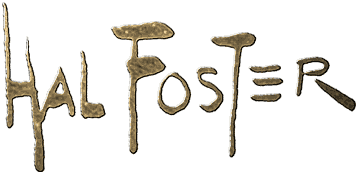 |
Special Guest Biographer - Brian Kane |
|
Author Brian Kane wrote a biography of Hal Foster published in November 2001 by Vanguard Press. Here is a dramatically condensed preview. I'm grateful for the honor. |
Harold Rudolf Foster's life was an adventure only equaled by those of the characters he drew. "Hal" was born in Halifax, Nova Scotia, Canada, August 16, 1892. (The same time as Dorothy Lathrop, Dean Cornwell, Robert Lawson and Andrew Loomis.) At just eight years old, he captained a 12-foot raft (actually a plank) across Halifax Harbor. By ten he was skippering a 30-foot sloop in the Atlantic. Hal never became seasick. "It was the sea," he insisted, "that became Foster-sick." This attitude about life would drive him and would become the philosophical foundation for his greatest creation.
Hal's father died when he was four. His mother remarried eight years later. Hal's stepfather had little business sense, but he imbued Hal with a love of the outdoors and fishing in the untamed wilds around Halifax. In 1906 the family business failed which prompted a move to Winnipeg, Manitoba where they hoped to rebuild their fortune in the western land boom. Hal was 13 and ended his formal education at the ninth grade. He immediately began a course of self-education at The Winnipeg Carnegie Library. To learn anatomy Hal would go to his room and sketch himself nude in front of an old cracked mirror. He got fast out of necessity. "You learn to quick-sketch," said Foster, "because it's 20 to 30 [degrees] below zero."
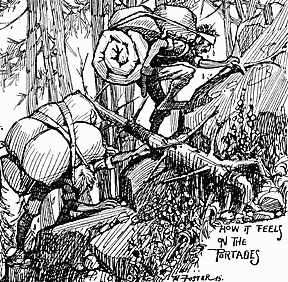 His
artistic influences were E.A.
Abbey (1852), Howard
Pyle (1853), Arthur
Rackham (1867), Maxfield
Parrish (1870), J.C.
Leyendecker (1874), James
Montgomery Flagg (1877), and N.C. Wyeth (1885). In 1910, he became a staff
artist with the Hudson Bay Company. Hal drew women's underwear,
the kind with numerous buttons and lace, for the mail order catalogue.
Canada's pre-war depression forced him into freelancing in 1913.
Hal met and married Helen Wells in 1915. The couple worked as
hunting guides in Ontario and Manitoba and in 1917, they found
a "million dollar claim" in the Lake Rice region and
began prospecting. They worked the gold mine for nearly three
years before claim jumpers stole it from them.
His
artistic influences were E.A.
Abbey (1852), Howard
Pyle (1853), Arthur
Rackham (1867), Maxfield
Parrish (1870), J.C.
Leyendecker (1874), James
Montgomery Flagg (1877), and N.C. Wyeth (1885). In 1910, he became a staff
artist with the Hudson Bay Company. Hal drew women's underwear,
the kind with numerous buttons and lace, for the mail order catalogue.
Canada's pre-war depression forced him into freelancing in 1913.
Hal met and married Helen Wells in 1915. The couple worked as
hunting guides in Ontario and Manitoba and in 1917, they found
a "million dollar claim" in the Lake Rice region and
began prospecting. They worked the gold mine for nearly three
years before claim jumpers stole it from them.
At twenty-eight, with a wife and two sons to support, Foster decided to seriously learn to be an artist. Hal talked a friend into joining him on a 1,000-mile bicycle trek from Winnipeg to Chicago. It took the two men fourteen days across dirt and gravel roads but on August 28th, 1919, they reached Chicago.
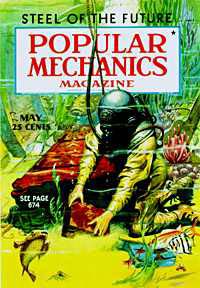 Foster
took a job with the Jahn & Ollier Engraving Company and enrolled
in evening classes at the Chicago Art Institute.
He later supplemented this education with night classes at the
National Academy of Design and the Chicago
Academy of Fine Arts. Eventually Foster went to work for
the prestigious Palenske-Young Studio illustrating
ads and magazine covers. He produced work for Northwest Paper,
Popular Mechanics, Jekle Margarine, Southern Pacific Railroad,
Illinois Pacific Railroad, and others.
Foster
took a job with the Jahn & Ollier Engraving Company and enrolled
in evening classes at the Chicago Art Institute.
He later supplemented this education with night classes at the
National Academy of Design and the Chicago
Academy of Fine Arts. Eventually Foster went to work for
the prestigious Palenske-Young Studio illustrating
ads and magazine covers. He produced work for Northwest Paper,
Popular Mechanics, Jekle Margarine, Southern Pacific Railroad,
Illinois Pacific Railroad, and others.
In 1927, Joseph H. Neebe, an associate of Foster's, went to Tarzana, California to meet with Edgar Rice Burroughs. Neebe, founder of "Famous Books and Plays, Inc." had originated the idea of adapting popular material into comic strips. Neebe wanted to adapt Tarzan of the Apes (first serialized in 1912) into a cartoon strip and Burroughs agreed. Originally, Neebe approached Tarzan cover artist J. Allen St. John to do the adaptation but St. John declined once he learned what the deadlines were. Neebe needed an illustrator with the sensibilities of a fine artist; so he went to his second choice.
The Tarzan comic strip, illustrated by 36-year-old Harold R. Foster, was introduced to the American and Canadian audiences on January 7, 1929. Dick Calkin's Buck Rogers also debuted that same day , but it was Foster's sense of realism, composition, draftsmanship, and his fluid anatomy that would forever mark him as "The Father of the Adventure Strip." In addition to these two great features, 1929 heralded the first appearances of Popeye in Segar's Thimble Theatre, Clifford McBride's Napoleon, and in Belgium, Herge's (Georges Remi's) Tintin.
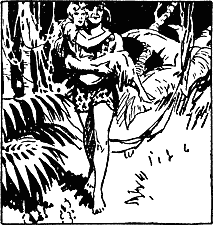
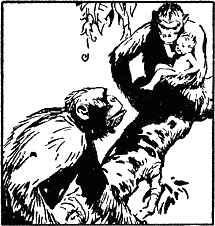 Foster created
the definitive Tarzan. He established a look of
nobility and aristocracy that would influence Burne Hogarth, Rubimor (Amilcar Ruben Moreira),
Bob Lubbers, Russ Manning, Gil Kane, Mike Grell, Gray Morrow,
Joe Kubert, John Buscema, and every other artist who illustrated
the Ape-Man. Another Foster trademark that appeared for the first
time in comics was the use of captions instead of word balloons.
This technique, called a story-strip, allowed Foster to create
compositions containing amazingly detailed backgrounds unhindered
by text. "I had no instructions at all, just the book."
Foster claimed, "I did the adaptation myself." When
he finished his adaptation of Tarzan of the Apes, he had
drawn 300 panels.
Foster created
the definitive Tarzan. He established a look of
nobility and aristocracy that would influence Burne Hogarth, Rubimor (Amilcar Ruben Moreira),
Bob Lubbers, Russ Manning, Gil Kane, Mike Grell, Gray Morrow,
Joe Kubert, John Buscema, and every other artist who illustrated
the Ape-Man. Another Foster trademark that appeared for the first
time in comics was the use of captions instead of word balloons.
This technique, called a story-strip, allowed Foster to create
compositions containing amazingly detailed backgrounds unhindered
by text. "I had no instructions at all, just the book."
Foster claimed, "I did the adaptation myself." When
he finished his adaptation of Tarzan of the Apes, he had
drawn 300 panels.
After the initial run, Foster went back to advertising. "Famous Books and Plays" turned to The Metropolitan Newspaper Service (later renamed United Features Syndicate) bull-pen artist Rex Hayden Maxon to draw Tarzan. Hal considered himself an artist first and felt cartooning was an inferior medium. Later that year The Great Depression saw an end to most of the advertising dollars and the advertising agency Foster was working at was close to closing.
"Then Tarzan came along." At Edgar Rice Burroughs' request, Neebe once more sought out Foster. He still felt he would be prostituting his talent, but with no work coming in he begrudgingly accepted the offer. "I was a bit offended to be asked to sell my birthright for a mess of pottage. But I thought, 'Wouldn't it be nice if I had a little bit of pottage right now?'" On September 27, 1931 Foster took over the Tarzan Sunday page (Maxon continued on the dailies). Starvation and Tarzan brought Foster back into cartooning.
The 1930's ushered in many important comic strips and set new artistic standards for creators. Chic Young's Blondie first appeared in 1930. Chester Gould's Dick Tracy began in 1931, and Foster returned to illustrate the Tarzan Sunday strip. Alex Raymond created Flash Gordon, Jungle Jim and (with Dashiell Hammett) Secret Agent X-9 in 1934, while Al Capp's Li'l Abner, Lee Falk & Phil Davis' Mandrake the Magician, and Milton Caniff's Terry & The Pirates also debuted that year. Mickey Mouse Magazine and Zane Grey's King of the Royal Mounted were published in 1935 and in 1936, Lee Falk & Ray Moore's The Phantom began haunting the jungles.
Ever gracious with his good fortune, Hal parceled out assignments to his fellow artists and paid them from his earnings. Initially Foster was content to scratch out the pages, but then the fan letters started coming. The strip became a source of pride and he brought to it all of his talents. Foster was the first illustrator to bring a painterly, impressionistic approach to comics, and an early experimenter with chiaroscuro. He paved the way for cartoonists like Noel Sickles and Milton Caniff. In Foster's hands the Tarzan strip became as epic as any movie. His two-year "Egyptian" sequence is one of the watershed events in the medium and its quality and consistency has never been matched.

Frustrated over poor scripts and the creative constraints imposed on him by laboring on someone else's property, Foster began working on a character of his own, Derek, Son of Thane. Hal later changed the strip's title to Prince Arn and King Features Syndicate's general manager, Joseph Connelly would finally re-christen it Prince Valiant. Hal decided early on that his hero would be a Knight of the Round Table and made tens of thousands of notes and sketches. By the time he was done he'd laid out the history of "The Prince of Thule" from his earliest days to his old age. In 1936, Foster approached United Features Syndicate with his idea. In what is considered by most to be one of the worst business decisions in the history of comic strips, they turned him down.
Foster's offer to United Features was simply a courtesy. William Randolph Hearst wanted Foster and "what Hearst wanted Hearst got." During the previous eighteen months, Hal had been corresponding with a representative from Hearst's King Features Syndicate. The newspaper tycoon was so impressed with Foster's work on Tarzan that he promised Hal complete ownership of any comic strip he developed—a very rare offer in those days. Unknowingly, Hearst let Foster go in 1928, when he turned down Joseph Neebe's original Tarzan proposal and he wasn't about to make the same mistake again.
The first episode of Prince Valiant in the Days of King Arthur appeared on February 13, 1937. Foster was 44.
The mythology Foster created was captivating. King Aguar was driven from Thule (now Norway) by the usurper Sligon. The deposed monarch fled with his queen and young son, Prince Valiant to the wild fens of Britain. Val loses his mother at a young age then decides to venture off to become a knight. Along the way he acquires "Flamberge - The Singing Sword," a blade forged by the same mage who created Arthur's legendary Excalibur . He is knighted by King Arthur on the field of battle, helps his father reclaim his throne, and later wins the heart of Aleta, Queen of the Misty Isles whom he marries. The tales were so epic that Edward, The Duke of Windsor called Prince Valiant the "greatest contribution to English literature in the past hundred years."

 It
took Foster fifty to sixty hours a week to produce each Sunday
strip but King Features never had to worry about deadline problems
because he was always 9 to 12 weeks ahead of schedule. Hal never
included a locale that he had not personally visited for thematic
accuracy. In 1944, the Fosters moved to Redding, Connecticut.
The six-acre lot helped Foster get back to his roots and may have
inspired Val's trip to "The New World" (1947). The strip
also reflected the spirit of its audience. During the era of the
post-war baby boom, Val wins the heart of Aleta, marries her in 1946, and the two have
a son they name Arn (1947).
It
took Foster fifty to sixty hours a week to produce each Sunday
strip but King Features never had to worry about deadline problems
because he was always 9 to 12 weeks ahead of schedule. Hal never
included a locale that he had not personally visited for thematic
accuracy. In 1944, the Fosters moved to Redding, Connecticut.
The six-acre lot helped Foster get back to his roots and may have
inspired Val's trip to "The New World" (1947). The strip
also reflected the spirit of its audience. During the era of the
post-war baby boom, Val wins the heart of Aleta, marries her in 1946, and the two have
a son they name Arn (1947).

In addition to his work on Prince Valiant, he illustrated the book The Young Knight in 1945, and had previously done a b&w daily strip in 1943 adapting the popular book The Song of Bernadette (above). During this very productive period, he also crafted a "header" strip titled The Medieval Castle. This was a removable tier below the Valiant page to accommodate various newspaper formats. It was collected into a book of the same title in 1957 by Hastings House. This same company published a series of seven books adapting Val's adventures into hardcover with Foster's art utilized throughout in glorious black and white.
Prince Valiant became one of the most successful comic series of all time, winning the prestigious Banshees' "Silver Lady" award (1952) and both the National Cartoonists Society's coveted "Reuben" award (1957) and "Gold Key" award (1977). When he was 73, Foster was elected to membership in Great Britain's Royal Society of Arts - an honor very few Americans can claim.
In addition to Wayne Boring, who assisted Foster on the strip from 1966-69, there were two other artists who have seldom been mentioned. Hal's son, Arthur James Foster had studied art and assisted Hal for twenty years inking backgrounds and coloring. He was also president of the Art Student's League in New York from 1958 to 1965. Arthur and Hal had their differences and Prince Valiant was neither Arthur's strip nor his passion. To have followed his father on Prince Valiant would have been a thankless job and Arthur knew it. He never wanted to inherit the strip and keep it in the family. In the early 1960's Philip "Tex" Blaisdell helped Hal produce some pages. Originally Blaisdell penciled and inked the backgrounds but as time progressed so did his responsibilities. Lee Marrs, Blaisdell's assistant, recalled that Tex eventually was doing everything but the faces of the main characters while she contributed as a background inker.

Hal Foster breakdowns and John Cullen Murphy's finished illustration
In 1971, Foster began actively seeking another artist to permanently carry on the strip. The decision was a hard one but arthritis had begun to affect his drawing and Foster refused to produce "amateurish work." Gray Morrow, Wally Wood, and John Cullen Murphy were chosen to do tryout pages. All the pages were beautifully crafted but only one artist could be chosen. Foster decided that Murphy, a former World War II field illustrator and creator of the strip Big Ben Bolt, would be his successor. Page 1788, which appeared on May 16, 1971, was the last completely written and illustrated by its creator. He had produced 1,764 Prince Valiant pages. Foster continued to do layouts, write and color the strip for the next nine years. On February 10, 1980, just three days shy of 43 years, the last Prince Valiant strip written by Foster saw print. Foster died only two years later on July 25, 1982, three weeks before his 90th birthday.
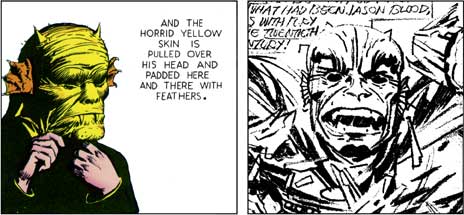 |
|
| Val in disguise, 1937 | Jack Kirby's Demon, 1972 |
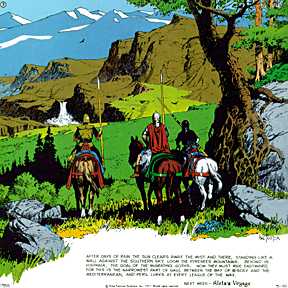 Hal
Foster's work has inspired generations of artists including Jack
Kirby (see above), Lou Fine, Frank
Frazetta, Al Williamson, Wayne Boring, Joe Kubert, Russ Manning,
Frank Thorne, Dave Stevens, Charles Vess, William Stout, Mark
Schultz and many others. Even the great Disney artist, Carl Barks once said that he kept Foster's
water scenes as reference because he was the only one who could
get it right. Without intending to Foster created a bridge between
the Golden Age of Illustration and the present.
Hal
Foster's work has inspired generations of artists including Jack
Kirby (see above), Lou Fine, Frank
Frazetta, Al Williamson, Wayne Boring, Joe Kubert, Russ Manning,
Frank Thorne, Dave Stevens, Charles Vess, William Stout, Mark
Schultz and many others. Even the great Disney artist, Carl Barks once said that he kept Foster's
water scenes as reference because he was the only one who could
get it right. Without intending to Foster created a bridge between
the Golden Age of Illustration and the present.
| Thanks once more to the most generous Brian Kane for not only giving us a foretaste of his book, but also for giving me a week off! |
 To learn more about Hal Foster, see:
To learn more about Hal Foster, see:| Prince Valiant's Hal Foster | Pageant, Vol. 5, No. 6, December, 1949 |
| Hal Foster interviewed by Gil Kane - July 1969 | 1970 Comic Art Convention Program Book |
| Prince Harold | Arn Saba, Toronto Star, Canadian Weekend supplement, December 8, 1979 |
| Prince Valiant's Hal Foster | Near Mint #19 March 1982 |
| obituary | The Comic Reader, #204, September 1982 |
| Prince Valiant: An American Epic Vol. 1 - 3 | Rick Norwood, Manuscript Press 1982 + |
| Meet Harold R. Foster and Prince Valiant | Edgar W. Brown, Near Mint #29, June, 1983 |
| The Master, Hal Foster (interview conducted 1969) | Fred Schreiber, Nemo #9. Fantagraphics 1984 |
| Prince Valiant Vol. 1 - 40 | Hal Foster, Fantagraphics 1984-1998 |
| Drawing Upon History (interview conducted 1979) | Arn Saba, The Comics Journal #102, Fantagraphics 1985 |
| Tarzan in Color, Vol. 1 - 6 | Hal Foster, NBM 1993 |
| "The Christmas Story" | Hal Foster, reprinted Comics Review #129, 1996 |
| Howard Pyle and the Roots of the Artistry of Hal Foster | Giulio C. Cuccolini, Hogan's Alley #5, Bull Moose 1998 |
| The Vadeboncoeur Collection of Knowledge | Jim Vadeboncoeur, Jr. 2001 |
|
Illustrations are copyright
by their respective owners. This page written by Brian Kane, designed & © 2001 by Jim Vadeboncoeur, Jr. Updated 2011. |
